Academic Achievements
This page contains a collections of my Academic Achievements
Master Thesis
Exploring Non-Fungible Tokens (NFTs)
Summary
This master thesis delves into the realm of Non-Fungible Tokens (NFTs), distributed system and their diverse applications. NFTs have gained recognition across various domains, from simple image-based projects to complex systems such as voting, IoT authentication, and ticketing services. While businesses acknowledge the potential of unique tokens, the average consumer's understanding and appreciation of NFTs remain limited.A preliminary questionnaire involving 123 participants shed light on the prevailing perception of NFTs. While people grasp the concept of uniqueness, they often view NFTs as mass-produced images marketed as investment opportunities, which fosters skepticism. The immaterial nature of NFTs compounds this skepticism.
The primary contribution of this thesis is the FUDOT framework, which serves as a comprehensive survey and categorization of various NFT projects. The framework identifies shared attributes and illustrates them with real-world examples. The subsequent chapters delve into the FUDOT framework's development and analysis.
Through this framework, a gap in NFT technology is discovered, particularly regarding Tangible Interfaces. Research and business projects utilizing Tangible Interfaces with NFTs are underexplored, despite the potential to empower users and engage them in physical exploration and sociospatial configurations.
The identified gap between Tangible Interfaces and NFTs, along with the findings from the preliminary questionnaire, shapes the central research question of this thesis: "What are the benefits and limitations of using Tangible User Interfaces as an interaction medium for NFTs, and can physical representations enhance the perceived sense of ownership of NFTs?"
The subsequent sections of this thesis explore the development and evaluation of Terragon, a project aimed at addressing this research question. Terragon bridges the gap in the FUDOT framework and offers a physical representation of an NFT, enabling direct interaction with the token. Through user studies and extended evaluations, Terragon challenges users' perceptions of NFTs and their sense of ownership by introducing bodily interactions and uniqueness to the NFT experience.
@bstract
Architecture

The project can be found at github: Tangible NFT and the thesis is available here: Master thesis
Bachelor Thesis
Web-based Visualization for Exploring Public School Data
Summery
The bachelor thesis, in abstract terms, tackles the problem of gathering a large dataset online, processing it, and presenting the data to a large user-group. In more a concrete context we gathered the data available on public schools in Denmark, processed the data, and created a web-based visualization tool that allows users to search and filter differed schools. The bachelor thesis was written with Aron and Alex and supervised by Hans-JörgAbstract
The Danish government encourages all public schools in Denmark to provide as many statistics as possible to The Danish Ministry of Education and Research to store, analyze, and publish on uddannelsesstatistik.dk. Navigating the aforementioned website and exploring the data provided is a labor-intensive and a non-user-friendly task. The data is spread across multiple sites and difficult to work with.By identifying the users' requirements in the context of searching for information on public school data, we discovered a demand for a platform that allows users to easily navigate and explore such data. In the process of conceptualizing such an application, we found the literature insufficient in terms of presenting a general solution to visualize heterogeneous data sets to a broad user group.
From this we formulated our hypothesis: Can we solve to the challenge of visualizing heterogeneous data sets to a broad user group by developing and implementing a framework that generalizes a solution the challenge. This resulted in the creation of the DEEVA Framework, that aims to support developers in the process of building visualization applications. To confirm or disprove the hypothesis, we created an application with a user-friendly interface that facilitates data exploration with a focus on the iterative process. Results from the evaluation confirmed our hypothesis. However further iterations of the framework are needed to fully realize its potential.
Data Gathering Tool
We approached the challenge of scraping web data by developing a software layer on top of
Selenium that can be fed a set of instructions, interpret them, and execute the given
commands.
The advantage of this approach was maintainability. If a value changed, a new one was added,
we did not need to go into the code and change it. We can simply change the instruction file
to accommodate the new changes. Meaning that in future work, we could develop more sophisticated
detection software which outputs the instruction JSON file.
{
"instructions": [
{
"get": "https://targetwebsite.com/api"
},
{
"switch": "WebApplicationFrame"
},
{
"wait": 2
}
]
}Visualization Tool
Filtering Data
To filter the data we implemented filtering parameters which utilizes scented widgets. Scented Widgets are a form of dynamic query which increases usability in information spaces. The widgets use embedded visualizations on top of graphical user interface controls to enhance exploration of data sets. A scent is generated from social data of other users behavior or data-driven metrics. This scent lowers the "cost" of information gathering and improves exploration of the set.

Relating diffrend data points
The Relation Phase is centered around a main graphing area where users can choose between different categories on the x- and y-axis through a drop down menu. The designer choice means that if users want to see a graph of grades over income, they have the ability to select them on the different axis. Allowing the users to chose what data is plotted is a better way to drive exploration, because we are not limiting the visualizations to comparisons that we as developers can think of

the full project can be found at github: visualization web application the thesis is available here: bachelor thesis
Phystically Uncloneable Functions
Introduction
This Paper, addresses the pervasive challenges associated with counterfeit luxury items and theft in the high-end consumer electronics market. In a more specific context, we propose a solution centered around Physical Unclonable Function (PUF) hardware for authentication. This system includes a mobile application that empowers users to verify product integrity and a backend server for secure data storage and verification.The project was a collaborative effort, written with Thor Andresen and Mathias Laursen, under the guidance of Niels Olof Bouvin, with a focus on enhancing security and integrity in the high-end consumer electronics sector.
Abstract -
In the world of luxury goods and high-end consumer electronics, the threat of theft and counterfeiting looms large, endangering both consumers and manufacturers. Traditional security measures, such as certificates of ownership and serial numbers, have proven vulnerable to manipulation and theft.This thesis presents a novel solution based on Physical Unclonable Function (PUF) technology to address these challenges. PUFs rely on challenge-response pairs (CRP) that resist brute force attacks and replication attempts, providing robust authentication. To make this technology accessible to consumers, a mobile application is developed, empowering users to easily verify the authenticity and integrity of physical products. Complementing the PUF-based authentication system is a backend server, responsible for verifying product integrity, state, and history. This data is securely stored in a database, ensuring the accuracy of product information.
The proposed system is designed from the perspective of manufacturers, specifically targeting the market of high-end consumer electronics, such as mobile speakers with price ranges spanning from 5000 to 30000 Danish Kroner. This architecture can be adapted for use in other premium consumer electronics segments, offering enhanced security and integrity, benefiting both end consumers and manufacturers. With this innovative approach, the landscape of luxury goods and high-end electronics may see a transformation, reducing the threats of theft and counterfeiting, and enhancing overall product trustworthiness.